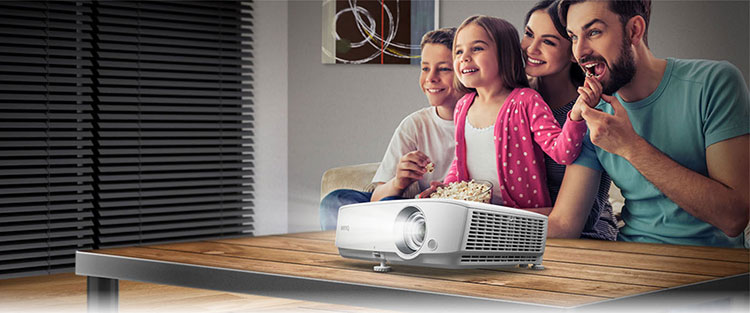
If you bought a cheap display, it wouldn’t render accurate color. And often, there was no way to fix the problem without delving into the double-secret service menu. I spent many hours exploring these cryptic screens searching for the right options to adjust grayscale and gamma. Color management? Fuhgeddaboudit. If you wanted the fancy color controls, you bought a Runco or a Pioneer Elite, or something of that ilk. And even those TVs and projectors required an instrumented calibration to deliver their full potential.
Today, there are few products that don’t deliver decent out-of-box color. And virtually everything comes with a comprehensive menu system that allows adjustment of grayscale, gamma, and color gamut. These displays have become incredibly affordable. But that has created a surprising downside. Good projectors are now so cheap that no one opts to invest an extra $300 or $400 for a professional calibration. If out-of-box color is so good, why bother?
When you’re on a budget, and an excellent projector is less than $1,500, it only makes sense to pick the one with the best color accuracy. Professional calibration is not a consideration, so all one needs to do is find the product with the highest precision that fits the intended use and environment. So, why does all this even matter? Let’s take a look.
Read any projector review and you’ll see multiple references to things like “Rec.709”, “D65”, and the like. Enthusiasts know that they refer to a color gamut standard and a white point value, respectively. But how did they come to be? Who decided that a neutral white should have a color temperature of 6,500 Kelvins, and a display’s primary colors should correspond to a particular set of CIE coordinates? For those answers, we must look to SMPTE or, the Society of Motion Picture and Television Engineers.
Quite simply, color gamut standards grew from the capabilities of existing display technology. Below is shown a CIE chart. The colored section shows the spectrum of color visible to the human eye. The gold triangle inside it is the Rec.709 standard. It specifies the position of the three primary colors, red, green, and blue, within that spectrum. These are the values that have been in place since the advent of high-definition, 720p, 1080i, and 1080p resolutions. This gamut is a hair larger than the one used by the first CRT-based color televisions. That standard was known as Rec.601. It’s found today on every DVD since they are still based on the standard-definition (480i & 480p) parameters.
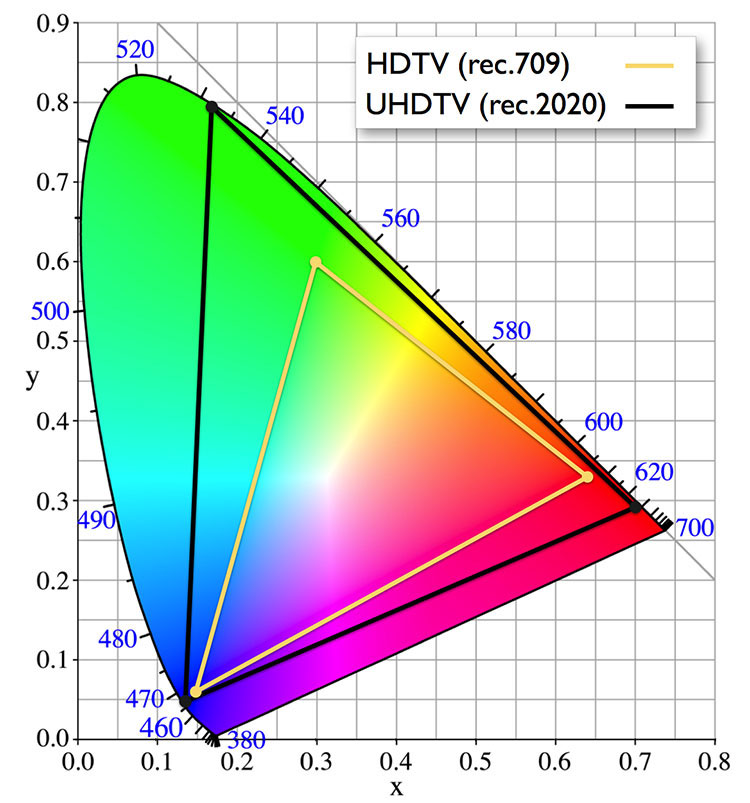
Incorporated into Rec.709 is a white point of 6,500 Kelvins, D65, and at least two different gamma specs. Early HD material was mastered using the 2.2 power function, but today’s content uses a slightly different parameter known as BT.1886. Though that spec has been in place for several years now, only a small number of displays actually conform to it. Most of the projectors and TVs I’ve reviewed still come closer to the power function at values ranging from 2.1 to 2.4.
So, why does all this matter? Because any form of video reproduction has the goal of faithfully reproducing reality from a video or projection screen. Artistic interpretation aside, every viewer wants their TV to look like the view out a window. To achieve this reality, the standards I just mentioned must be adhered to from the moment a camera is powered on, through post-production and finishing, and when that content reaches your display. To do otherwise is to alter the image originally seen by the people who created it. Will they care? Probably not. But you should. Would you view the Mona Lisa through a pair of rose-colored glasses?
Directors often use color to convey moods and feelings in a movie. The terrifying and intense atmosphere of a prison is far more effectively conveyed when its cast in just the right shade of metallic blue. If your display doesn’t reproduce that, your perception won’t be the same. It won’t be what the director intended.
Today, we have a vast number of products vying for your hard-earned dollars. Televisions are commonly sold with Ultra HD resolution (4K), but projectors are still growing on that front. Most two-piece systems still use good ole’ 1080p. And why not? It’s still what’s found on the millions of standard Blu-ray discs that are sold every day, and the 1080i content sent out by nearly all cable and wireless broadcasters, and the thousands of channels of streamed content gushing over the Internet. 4K is great, and all but reality says that we’ll be watching 1080p for some time to come. And that’s why Rec.709 color is so important.
Secrets Sponsor
In a day where display manufacturers try to outdo each other by adding size to the color gamut and heaping on extra image enhancements, it’s still paramount that those TVs and projectors be able to accurately and precisely show us Rec.709 color with a D65 white point. Extended color? Yes, you want it, but it needs to come with an off-switch. If you’re stuck with a single large gamut, most of the content you watch will not look right. It won’t be what its creators intended for you to see.
If you buy a new projector these days, it’s hard to wind up with a bad product. All the name brands offer reasonably-priced models that perform well out of the box and offer full calibration capability. The biggest differences are in light output and lens configuration. Even in the under-$1,000 range, you can get decent color, a bright picture, and a full set of adjustments. The graphic below shows the white point and color management adjustments from a BenQ HT2550.
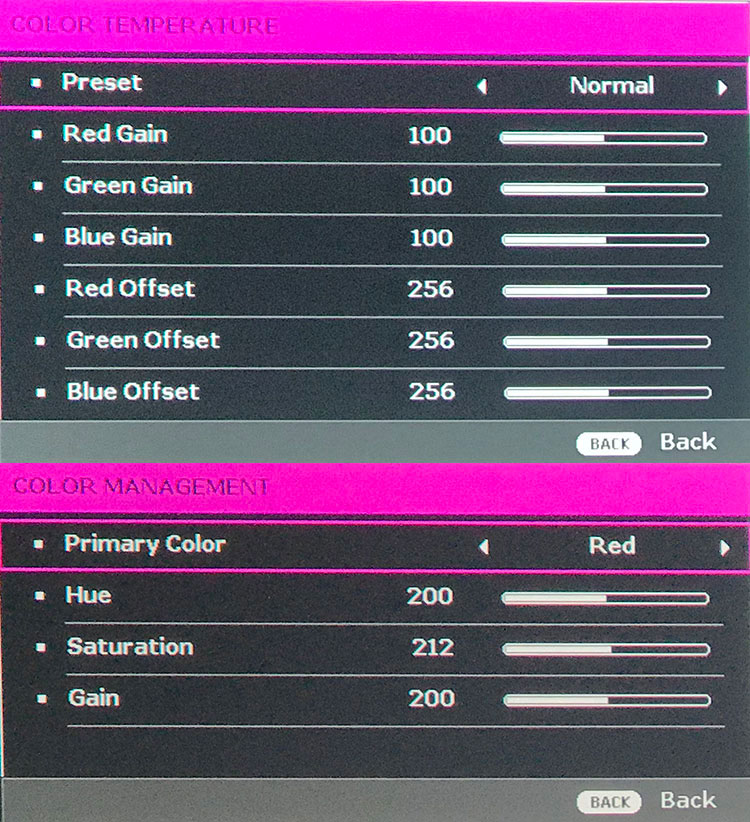
The top menu is a two-point adjustment where red, green, and blue levels can be altered for bright and dark areas of the image. This projector offers fine resolution with 200 steps for the gains and 512 for the offsets. The lower screen is the color management system. It allows alteration of the hue, saturation, and gain (luminance) of all six colors. Using these two menus lets the user dial in the picture so it conforms to the Rec.709 standard with a 6,500K white point.
In my projector reviews, I always test a projector’s default state in its most-accurate picture mode. It’s usually called something like Movie or Cinema. Often, it measures well enough that I could call it a day and watch some movies with a satisfying image that looks natural and bright. But, I always seek out a display’s full potential. There is always room for even better color, and usually, the changes improve contrast as well. While I don’t expect buyers of a $1,000 projector to drop an additional $400 on calibration, there are some users that will want every possible ounce of performance they can get.
A good median price for a projector at this writing is around $1,500. For that sum, which is less than the cost of many flat panel HDTV’s, you can get an Ultra HD DLP projector from BenQ, Optoma, or ViewSonic. The imaging chip has a native resolution of 1920 x 1080 pixels but through a seamless shift technique, it projects 3840 x 2160 pixels onto the screen. I’ve looked at a number of these models, and when it comes to clarity, I am hard-pressed to differentiate any of them from a native 4K projector.
Much of that is owed to the single-chip design. Three-chip displays like Sony’s VPL-VW285ES (around $4,000) look great, but unless the sample you’re viewing has flawless convergence of the three imaging chips, there will be some loss of resolution. We’re talking about minute differences here, but the fact is that a single-chip DLP will be perfect from sample to sample.
What you really pay for these days is contrast. I still maintain that it’s the most important aspect of image fidelity. That’s why an Anthem LTX-500 from 2009 still hangs in my theater. It delivers around 20,000:1 where the best DLP might offer 2000:1 with its dynamic bulb option engaged.
But color accuracy is not nearly as difficult to find as it was a few years ago.
I’ve already touched on the reason that color accuracy is important. But how does this affect a viewer’s long-term relationship with a display? Let’s look at a scenario I’ve experienced with some of my calibration clients.
Most of the people that hire me to calibrate their displays know what they’re paying for and often-times, have hired calibrators in the past to finish their AV systems. But some are first-timers who have never actually seen a properly-adjusted display. A few aren’t so sure they’ve made the right decision when I’ve finished because suddenly, their TV or projector isn’t showing them a searingly-bright, over-saturated image. I tell them to give it a week, then call me if they’re not satisfied. In 12 years, that phone has never rung. Not once. That tells me just how powerful the science behind SMPTE standards is. It isn’t just some arbitrary set of values, it has been arrived at through exhaustive research and testing of just how the human eye reacts to a video image.
This is why color accuracy is so important. If one is to enjoy a display long term, it needs to be right from the start. It’s no different than tuning a piano. One may not know why it doesn’t sound good, they just know that it needs to be fixed. Projectors are no different. You can live with poor color, but life is so much better when the picture looks right.
Another way to look at it is to compare the experience to audio fidelity. Most people are attracted to the speakers that play the loudest without taking frequency response or distortion into account. When they hear a properly-engineered and correctly installed set of boxes, they suddenly realize what’s been missing. One might have lived with bad sound for years never knowing how much better it could be, until it became better. Video fidelity is no different.
When one compares the specs of various projectors from different brands, it’s easy to think that many models are the same. That’s why it’s so important to research professional reviews that thoroughly test all aspects of a display’s performance. At Secrets, every display we review goes through the same set of benchmarks that compare measured performance to actual picture quality.
If you break down the tests into three areas, grayscale tracking, gamma, and color gamut, it becomes simple to see which models perform best. Some will do better in the out-of-box tests, while others realize their potential after calibration. If hiring a pro is in your budget, then head straight for the post-calibration tests. That will tell you what the projector’s maximum potential is. It’s also important to read the review’s calibration notes to see where compromises might have been made and what must be done to unlock all that performance. For those who don’t want to calibrate, you need go no further than the out-of-box tests. That will tell you what to expect by simply selecting the Movie or Cinema mode. But, reading the entire review might let you in on a few tweaks that can improve your viewing experience.
Here’s an example of a projector that delivers good out-of-box color accuracy.
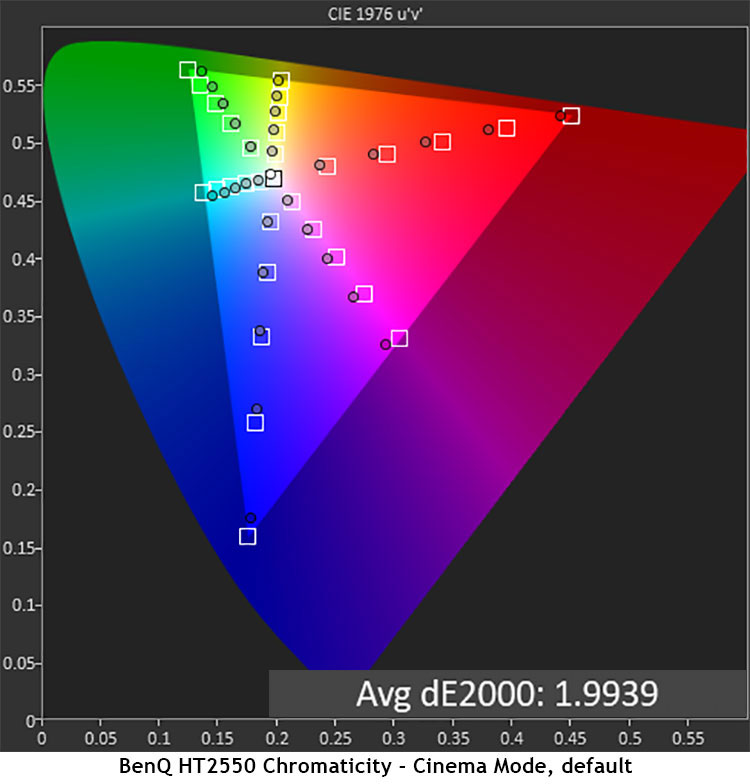
It isn’t perfect, but the average error of 1.99dE is below the visible threshold. The general consensus is that errors under 3dE cannot be seen by the naked eye. This matches my own experience. Once calibrated, the HT2550 makes some noticeable gains in the CIE chart where more of the color targets fall within their boxes.
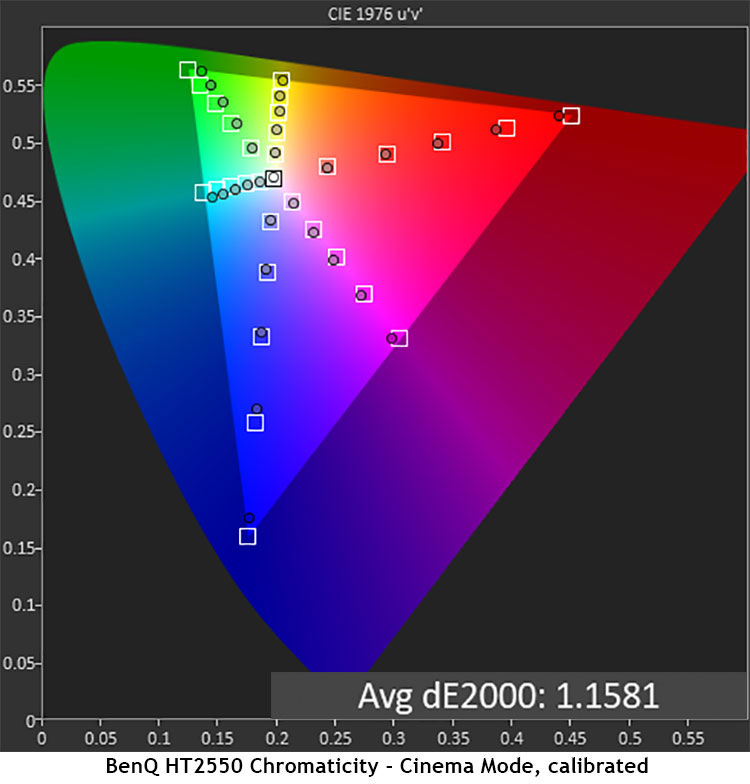
Until now, I’ve said nothing about HDR (High Dynamic Range) and extended color. The fact is, it’s here, and if you don’t already have it, you soon will. Most flat panels outside the bargain-basement price range have Ultra HD resolution (3840×2160) and HDR capability. The better TVs employ a multi-zone backlight for even better contrast. The latest crop of UHD DLP projectors also feature HDR. Testing is important there too. Here’s the latest data from a VIZIO P65-F1 65-inch television.
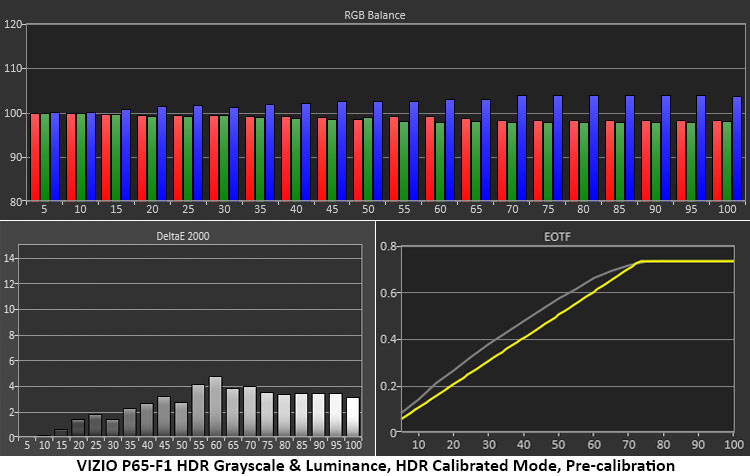
This is the panel’s default state in HDR10 mode, it also supports Dolby Vision. You can see that it’s pretty much right on the money, with no need for calibration.
Here’s the color chart where I test its ability to render the DCI-P3 gamut.
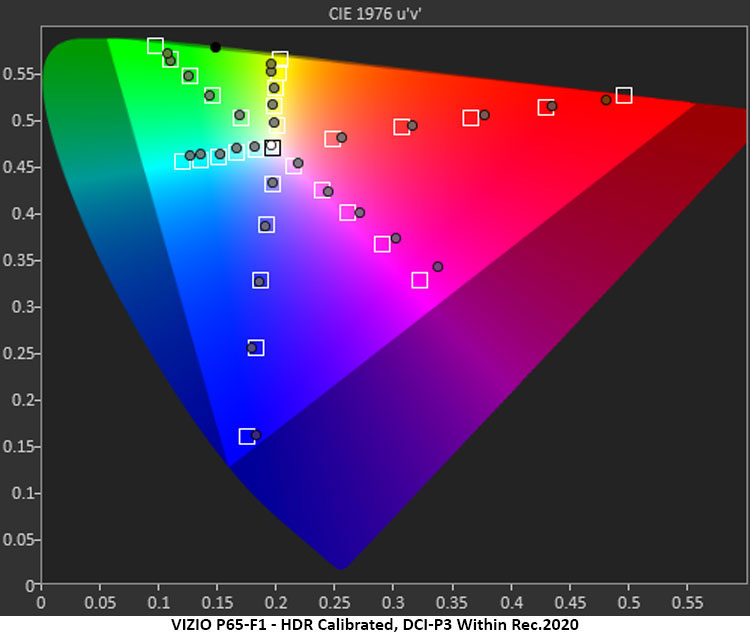
This display is one of the best I’ve tested to date. It is a textbook example of high color accuracy in HDR mode. When you read a review and see charts like these, that is the display to buy.
Secrets Sponsor
Accuracy aside, it’s also important to consider your environment when shopping for a new projector. Ask yourself a few questions: Will the room be completely blacked out, or will there be some ambient light? A light-controlled room can make do with a less-bright projector, and many of them offer better color accuracy. An example is the BenQ TK800 versus the BenQ HT2550. The former has about 30% more light but uses a different color wheel which reduces color accuracy and saturation slightly. If you can do with 2,000 lumens, the HT2550 is the better choice for ultimate image fidelity. If you will have some ambient light present, the TK800 is better-equipped to compete with that. Add an ambient light rejecting screen and you can have video nirvana without sitting in complete darkness.
As always, there are compromises. If high contrast and low black levels are your ultimate goal, you will have to spend more and give up a bit of clarity as well. That’s the domain of Sony and JVC LCoS and Epson’s LCD designs. They offer excellent accuracy, higher contrast, and deeper blacks than typical DLPs.
Though I always recommend calibration, it is not always realistic when modest budgets are considered. As I’ve already said, there are good projectors that come close to spec out of the box, and often, one can tweak a few settings to make things better without hiring a pro. I say again, read the reviews. Time spent on research can guide you to the right display for your needs and budget.
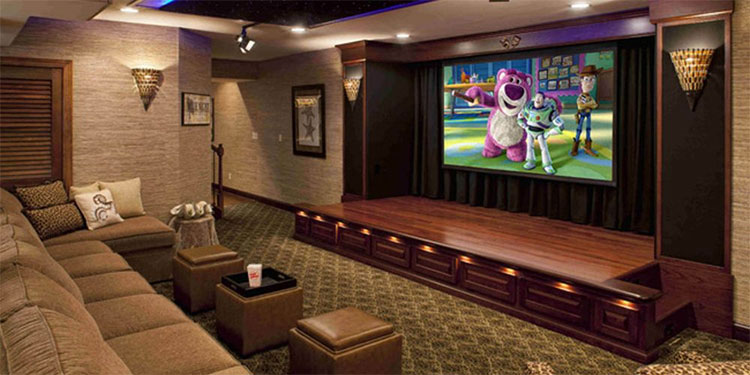
It has become much easier to make the right purchase when it comes to projectors. Competition has resulted in many high-performing models that deliver a stellar movie experience for prices at or below what one would pay for a nice flat panel. Calibration, though it nearly always brings improvement, is not necessary much of the time.
There is no question that you will enjoy movies and all kinds of video content more on an accurate display. Most viewers watch their TVs in ignorance of just how much better it could be. Once you’ve experienced a properly-engineered, color-accurate display, everything else just looks wrong. How many of you who already know this can’t stand to watch the TV blaring away in the average sports bar or hotel room? For long-term enjoyment, color accuracy is key.
To truly experience a movie the way a director intends, you must see it the same way they did. Sometimes, it only takes a fine tint to completely change the emotions being portrayed on screen. The actors have done their part, but the overall look must be preserved to get the maximum experience. Accurate color is paramount to achieving that goal. Can you imagine watching The Matrix without its signature green hues?
We’re at a turning point in display technology today. Many televisions are delivering Ultra HD resolution with HDR and extended color. But projector fans are still waiting patiently for all that wonderful tech to reach their theaters. We’ve seen good progress in the latest crop of Ultra HD DLPs that offer stunning clarity and decent HDR for just $1,500. And, if you have a more-generous budget, there are high-contrast models that can easily outdo what’s being shown at the local cinema.
The best part is, there are well-made projectors that offer that accuracy right out of the box without the need for a professional calibration. While it will always yield some gain, a satisfying image can come from simply setting them up and turning them on. And that is what we as professional calibrators and reviewers ultimately want. By doing the deep-dive and truly exploring a display’s capabilities, we make it easier for consumers to come to the right decision.


